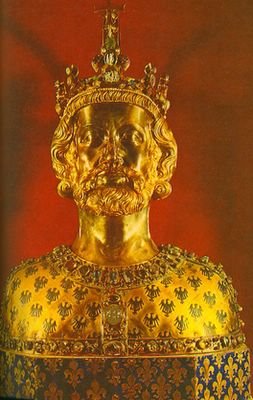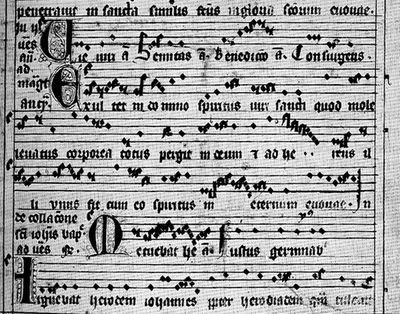Early Christian Music: Centonization and the Establishment of a Musical Liturgy
Christianity, of course, began in the Christianity absorbed several critical concepts from its parent religion Judaism (Jesus, if you recall, was a Jew). First and foremost was the concept of sacrifice. For Jewish priests, the sacrifice and burning of lambs upon the altar was a demonstration of faith to God. In Christianity, the sacrifice entailed that of Jesus, the Son of God, upon the cross. Sacrifice, then, is moved to a central place in Christian belief and worship. A second Jewish element to be absorbed was the singing of the Psalms in the synagogue and home. Early Christians continued the practice (the Old Testament is shared by both religions), and the Psalms became the source of texts for Chrisitan liturgical music.
Centonization and the Establishment of a Liturgy
As noted, early Christian music worship practices derived from the Jewish tradition, the singing of Psalms in the synagogue and at home. The Christian musical practice of chant began as an improvisational one called centonization. In the process of centonization, common musical motives (short melodic fragments) are placed in singing end to end to build up a longer melody. The order of motives may be changed to accommodate the changing emotions and lengths of different texts. The process lives on today in Blues (see "Centonization, A Still Viable Process" in the supplemental lecture New Millenium). By the eighth century many of the chants had been sung the same way so often that they began to assume a fixed form.
The components of the worship celebrations became standardized between the second and third centuries A.D. There were two different types of worship, one for the monastery and the other for the public. Monastery worship is called the Offices and consists of services spaced throughout each twenty-four hour period at intervals of about four hours. Some of the names of the specific services come to us today as the names of special choral concerts such as Vespers, Matins, etc. The worship service for the public is called the Mass. It is also divided into two parts, the Proper and the Ordinary. The content of the Proper is specific to the holiday. Each day of the year is a holiday, that is, a day representing some event in the life of Jesus. The Ordinary is a portion that does not change. It includes the Kyrie, Agnus Dei, Sanctus, Gloria, and Credo. The five portions of the Ordinary are especially important to the study of music because they have been traditionally the focus of composers' efforts.
In the early centuries of the Common Era, Christianity spread quietly but pervasively throughout the
The
As in the
The underlying reasons are manifold for the emergence in the fifth to eighth centuries of specific European liturgies. First, direct Eastern influence was cut off when the Empire split. Second, the Fall of Rome in 467 was accompanied by invasions by hordes from the steppes of central
Each of the different groups met particular worship needs by developing its own melodies for singing sacred texts. The generation of new melodies involved new composition, but as often the modification of chants inherited from Byzantine worship. The dialects to emerge included Gallic in
Codification of the Musical Liturgy
Pope Gregory II (c715 C.E.) desired that the chant repertory be codified, and he ordered that the chants be recorded in writing. Charlemagne (ruled as Emperor 800-814 C.E.) redoubled the efforts at standardization begun by pope Gregory and his father and predecessor, Pepin the Short. Charlemagne and Pepin the Short, before him, established the first great kingdom of
Reconciling the various dialects in codification presented problems, and ultimately the Gallic, Beneventan, and Ambrosian dialects were consciously supplanted by Old Roman rite. Mozarabic chant was not so easily displaced in
The process would have profound effects upon Western music. The completion of the codification process would give rise to Church prohibitions against changing the text or the notes of those chants included in the in the official sacred liturgy. Later musicians, for the most part monks, would find other ways to contribute to Church music, and their solutions would lead to the highest achievement of Western music, harmony.

Reliquary Bust of Charlemagne
Notation

Notation using heightened neumes represents a second step toward accurate notation. As in staffless notation, the singer was required to commit to memory the entire chant repertory as it was handed down by the older monks. Obviously, the neumes placed further above the text indicated higher pitches.

A critical forward step in accuracy came with the application of a horizontal line. The line represented a single, fixed pitch, and the singers could use that pitch as the standard against which to determine the relative location in sound of the other notes.

Staff notation, consisting of a four-line system, permitted the accurate notation of chant and, more importantly, the capability of a singer who did not know the chant ot render its notes correctly. The advance is recorded in Guido d'Arezzo's Micrologus (c1025) (Guido's contributions are assessed in subsequent Supplemental Lectures). A single but profound problem that remains today lies in interpreting the rhythm of the neumes.

Within chant, there are three classifications of the relationship of the text to the words. A syllabic setting is one in which one note is matched to one syllable. In a neumatic setting, several notes are matched to a single syllable. In a melismatic setting, many notes are sung to a single syllable. Florid melody typifying the last treatment is sometimes called a melisma.
Early Christian Thought On Music
Early church leaders and thinkers such as Clement of Alexandria, Origen, St. Basil, St. John Chrysostom, St. Ambrose, At. Augustine, and
Music in Medieval Europe also benefited directly from the writings of the ancient philosphers, arithemeticians, mathematicians, and music theorists. Their findings and empirical conclusions survived the tremendous political and social upheavals of the Fall of Rome in the writings of Martianus Capella and Ancilius Manlius Severinus Boethius.
Martianus Capella (early fifth century)
Martianus Capella was an important figure in the transmission of the knowledge of the ancient Greeks. His exstensive writings on the liberal arts had a significant impact upon the development of education in the West. He called the first three of the liberal arts, the verbal arts grammar, dialectic, and rhetoric, the trivium, or three paths. The remaining liberal arts consisted of the mathematical disciplines, geometry, arithmetic, astronomy, and harmonics. The mathematical arts were called by Boethius the quadrivium. The last of these, harmonics, consisted of the system of ratios in the intervals between musical pitches. Hence the study of music, albeit in a scientific form, became established early as a critical component of education.
Manlius Severinus Boethius (c480-c524/6)
Boethius was a Roman theorist. His compendium, De institutione musica (The Fundamentals of Music), became one of most important and influential documents of the Middle Ages. Boethius compiled is multi-volume work from the writings of other authors, most notable among them the Greek sources of Nicomachus and Ptolemy. Of the five volumes, the first three conveyed Pythagorean findings and conclusions. The fourth volume derived its content from Euclid and Aristoxenus. The fifth, which was partly anti-Pythagorean, was drawn from Ptolemy. The contradictions among the volumes did not seem a point of concern to medieval readers.
Boethius' most original contribution, however, was his division of music into three categories. The first, musica mundana, explained the movement of the planets, the changing of the seasons, and the elements as evidence of an underlying, orderly numerical system that controlled all aspects of the universe. The second category, musica humana, explains the relationship of the soul and the body and its regulation.
His third musical type, musica instrumentalis, focused upon audible music, whether produced by an instrument or the human voice. Like the earlier Greeks, he used the ratio of numbers to explain the intervals between musical pitches as an orderly system and stressed the behavioral impact of music upon humans. To this end he regarded musica instrumentalis as a critical component of education.
As noted in the entry regarding Capella's contributions, Boethius named the four liberal arts that embraced the mathematical disciplines the quadrivium. Boethius' musica instrumentalis fit into the category of harmonics. His understanding of musical study was not that meant in modern terms, that is the study of singing or playing an instrument. Instead, he advocated the study of the relative nature of musical pitches. He maintained that the true musician was not the singer, who sings by instinct, but the philosopher-mathematician who studies, measures, and critically assesses the medium and the relationships of the sounds produced in it.

<< Home